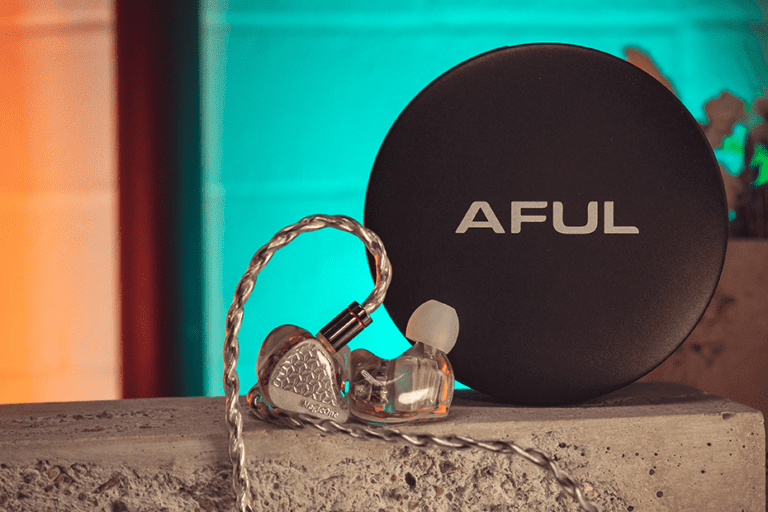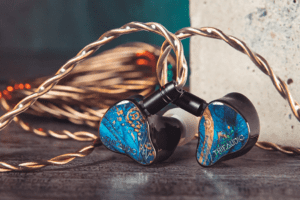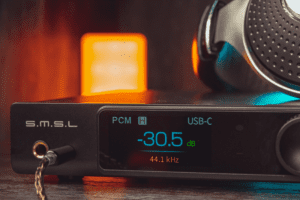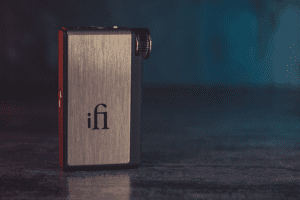Hello, I’m Alexander. Today we are checking the AFUL MagicOne in-ear monitors. It’s a single-balanced armature IEM and I want to thank HIFIGO for providing the sample for this review. As always, I’m not paid to make this review. I don’t offer any specific opinions. And all thoughts expressed in this review are my own.
The AFUL MagicOne features 1 balanced armature driver, light plastic shells, and a de-attachable cable. It also has an electronic circuit that shapes the tonality and a resonance chamber, nicknamed Nautilus, to enhance the bass response. But as usual, we will start with the unboxing.
The IEM arrived in a medium-sized box. There is the AFUL logo, an illustration of IEM, and main features on the front of the sleeve. The company information and specifications are on the back of the sleeve. Inside the sleeve, there is a black box. It contains the IEMs, a beautiful round carrying case, a detachable cable, 3 pairs of wide-bore silicone ear tips (one comes pre-installed on the IEM), 3 pairs of narrow-bore silicone ear tips, a warranty card, and a user manual. The impedance of MagicOne is 38 Ohms, and the sensitivity is 103 dB.
Design & build
The shells of AFUL MagicOne are made out of medical-grade resin. Each face plate has an interesting pattern. There is a company name on the left earpiece and the model name on the right earpiece. The shells are medium in size with a long nozzle which helps with the fit. The nozzle diameter is 5 mm. The IEMs have no vents and can build pressure over time. The resonance chamber and the resonator tubes, called Nautilus, serve one simple purpose: to shape and improve the bass response. And it’s quite good at this.
The cable that comes with this IEM is very good. You can order MagicOne with either 3.5 or 4.4mm termination. The sample in the review arrived with a 4.4mm cable. I don’t believe the cables impact the sound. But, I still care about cable quality, flexibility, and visual aesthetics. The included oxygen-free copper cable is 1.2 meters long. It has a 4.4mm connector termination on one end, and 0.78mm connector termination on the other.
The cable is low in microphonics, has a metal splitter and a metal chin slider, and compliments the IEMs. The connectors have blue and red circles indicating the channel. This is much better than single tiny dots that you can find on some cables.
Now briefly about fit and comfort. The MagicOne is lightweight and comfortable. Thanks to the shapes of the shell, nozzle length, diameter, and angle, I found a good fit with the stock ear tips. The seal still wasn’t perfect and I replaced the stock tips with Dunu’s S&S. MagicOne won’t tire you during long listening sessions due to their weight. But, the generic fit might not suit everyone’s ears, even though the long nozzle helps a bit in this regard.
AFUL MagicOne sound impressions
Now let’s talk about the sound. As always, all sound impressions on my channel are completely subjective. You should take them with a grain of salt.
The AFUL MagicOne has relatively high impedance and low sensitivity for an IEM. As a result, it requires some power to open up and shine. My Samsung Galaxy S10 is my first go-to device when I start IEM evaluation. But, it was struggling to provide enough power.
I recommend pairing MagicOne with dongles that provide at least 50 milliwatts of power at 32 Ohms. This will help to fully utilize its driver capabilities and tuning. In my tests, I paired MagicOne with iFi Go-Link and ddHiFi TC44PRO. I also tried it with my two desktop stacks, and that yielded very good results too.
While the market is oversaturated with single dynamic driver IEMs, there aren’t many single-balanced armature driver models available. And there is a reason for that. Shaping and tuning a single BA is quite difficult due to the BA driver’s limitations and capabilities. It requires a lot of knowledge and experience to do it right so I was a bit skeptical when I received the MagicOne, but it surprised me during the initial tests.
Enjoying this review useful? Read more IEM reviews here
This IEM has a good bass response for a single BA driver. This proves that the Nautilus resonant chamber design works. The bass is well-controlled, but of course, it lacks the body and punch of dynamic driver bass, still, it sounds clean and detailed. I particularly enjoyed the bass on well-recorded jazz, classical, and rock music. These music genres IMO don’t benefit much from a strong sub-bass rumble, but they need the bass to have details and texture. On EDM tracks the bass still lacked a bit of punch and body, so please consider this if EDM is a major part of your music library.
The midrange on AFUL MagicOne is fantastic. It’s very prominent, lush, engaging, and rich. There is some bass bleed into the midrange, but it’s not getting in the way. As a result, the vocals and instruments have a very natural sound. Both the lower midrange and the upper midrange are crisp and detailed. I found the midrange on MagicOne very enjoyable, especially with rock music. The electric guitars had enough bite and texture. The vocals sound fantastic, especially the female ones, and are well-rounded and lush with no hint of sibilance or harshness.
The treble is also a strong part of the tuning. It’s resolving, airy, and detailed. It leans a bit to the bright side and has a lot of air and sparkle, yet it still sounds clean and smooth. The treble reveals a lot of details and nuances, has a hint of an analytical sound signature, which can be a good thing if it’s your cup of tea, and is overall it’s a good example of a well-tuned treble. Of course, the single BA driver can’t compete with multi-BA configuration in regards to sparkle, definition, and separation. Yet, MagicOne is still good at it. In addition, its treble is smooth and it contributes to an enjoyable listening experience.
Technical performance
The AFUL MagicOne soundstage is above average in width and depth. Instruments hold their particular places in space well, and the soundstage is spacious. The imaging is good. The detail retrieval is good too, especially compared to many competitors in this price bracket. I feel there is no need to be exceptionally picky here.
The musical performance was great. Besides, it was also good in the games. It rendered a realistic gaming landscape with a good sense of distance and direction.
So what did I like about this IEM?
It’s great in terms of fit & comfort, comes with an excellent stock cable, has a full-range & accurate sounding single BA with excellent detail and clarity, also surprising bass response for a single BA, rich midrange with a good resolution, smooth treble with a good extension, good technical abilities, and a very good sound isolation.
What I didn’t like?
The IEM is source-picky and needs some power to shine. The pressure builds up due to its ventless design, the bass lacks a bit of body and sometimes the IEM sounds a bit congested on busy musical pieces.
Conclusions
Going with a single BA at this price point was a bold move, and I need to admit, that AFUL did a good job. They shaped and tuned the driver well. As a result, the MagicOne is a mid-centric IEM. It has a gentle bass and rounded treble, also has great texture, details, and presentation. It will appeal to those who value mid-range clarity over everything else and I can strongly recommend MagicOne as an overall package.
And that concludes my review for today. If you want to see more content like this consider subscribing to my YouTube channel for future updates. Thank you for joining me, and until next time, goodbye!
** As an Amazon Associate I earn from qualifying purchases. Some of the links in my reviews are affiliate links. At no extra cost to you, I will make a small commission if you click and make a qualifying purchase.



